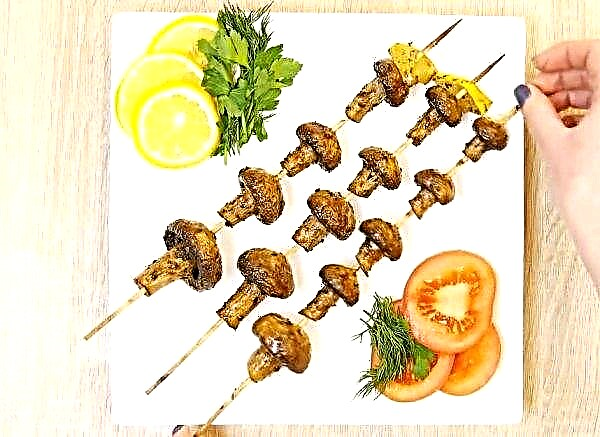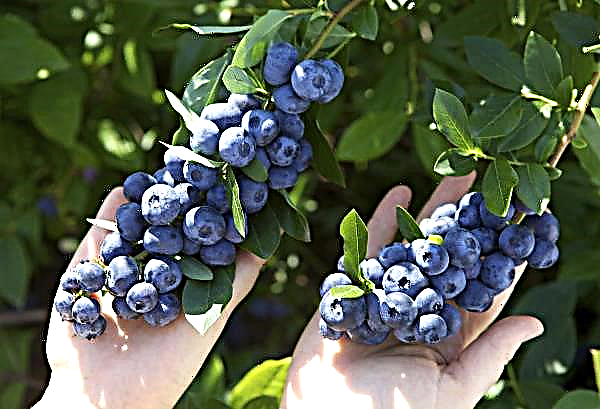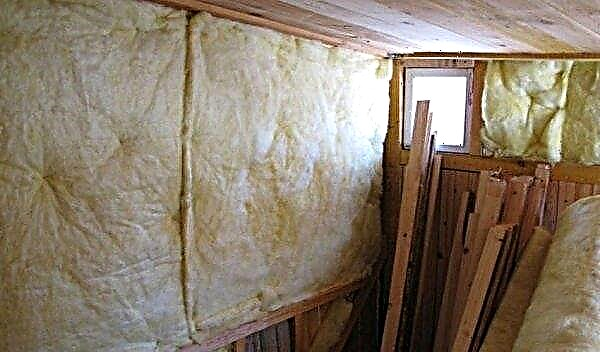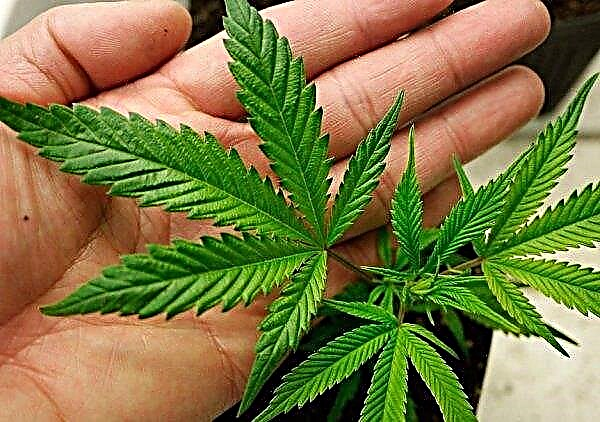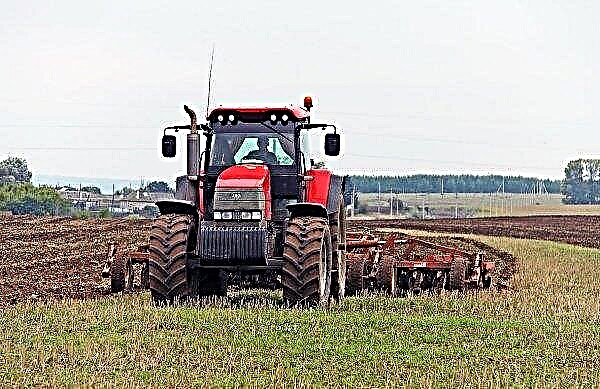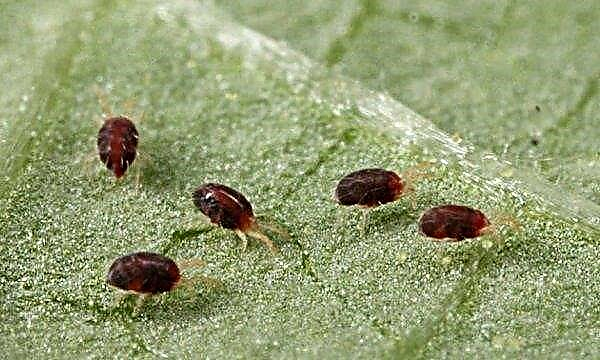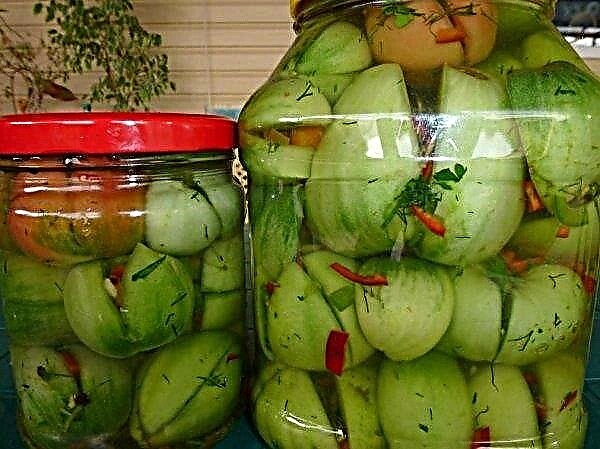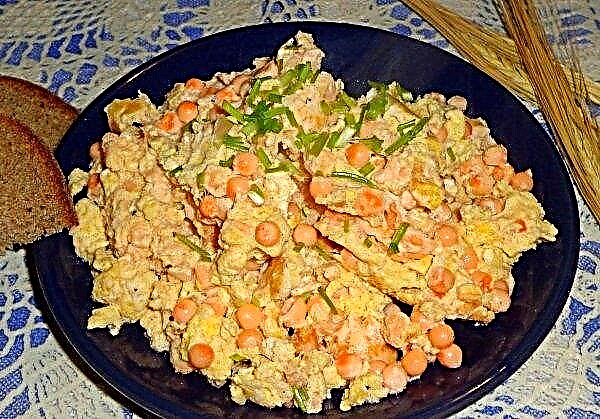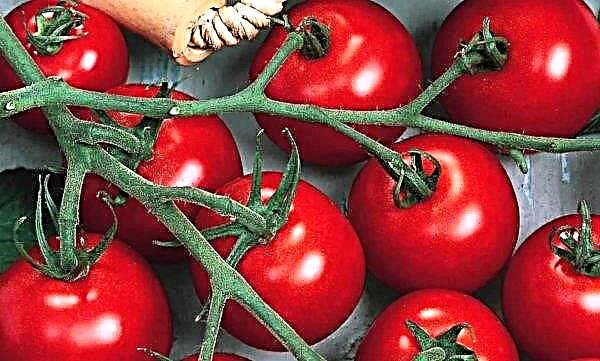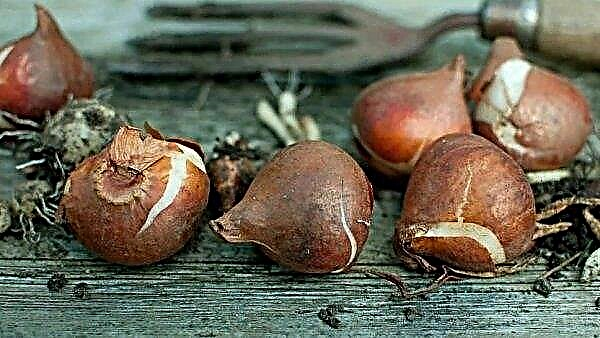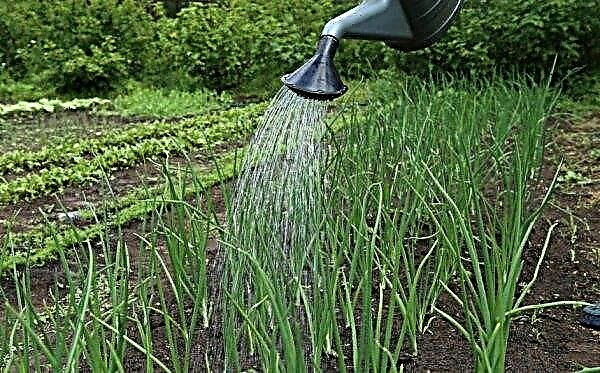1912 is considered the year of birth of the extraordinary evergreen creeper called Fatshedera. As the ancestors of the plant, the French flower growers, the Lizi brothers, chose ivy and Japanese fatsia, conducting selection work in the French arboretum of Nantes. Read more about the features of grooming and growing a hybrid “Frenchwoman” at home.
Botanical Description
Fatshedera is an exotic flower (rare, exotic), which soon after its appearance won the hearts of flower growers and florists. It is not only widely used in the design of floral arrangements, but also looks spectacular on balconies, terraces, conservatories, as well as in the lobby or large lounge.
They recognize fatsheder by large glossy leaves of dark green color, borrowed from fatsia and ivy - they never change their color. The dimensions of one sheet are impressive - 20 × 30 cm. The leaves have a triple or palmate-lobed shape.
Often, the edges of the leaves are framed by a kind of creamy or white border of irregular shape, which gives the flower even more elegance and beauty. This feature is characteristic of the subspecies of culture. The liana itself can grow up to 5 m. Initially, it has the shape of a tree with a slightly branched, semi-lignified, upright stalk; if desired, this form can be maintained constantly by using a support (stick made of wood or bamboo). Pinching the shoots to form an evergreen bush from the tree. In the absence of support, the flower stem begins to creep, and it gradually turns into a vine. Over time, the lignification of the stem begins and it becomes covered with a dark brown bark. The length of the fatsheder increases by 30–40 cm per year.
The liana itself can grow up to 5 m. Initially, it has the shape of a tree with a slightly branched, semi-lignified, upright stalk; if desired, this form can be maintained constantly by using a support (stick made of wood or bamboo). Pinching the shoots to form an evergreen bush from the tree. In the absence of support, the flower stem begins to creep, and it gradually turns into a vine. Over time, the lignification of the stem begins and it becomes covered with a dark brown bark. The length of the fatsheder increases by 30–40 cm per year.
Did you know? Fatscheder can often be found in large industrial enterprises, especially with harmful working conditions for people, where it is used not only for decorative purposes, but also as a means of improving working conditions. Culture is capable of absorbing harmful substances, and its appearance produces a calming and relaxing effect on workers.
In late summer - early autumn, spherical umbrellas, flowers of green-yellow, or cream color, appear on an adult vine. They are collected in paniculate inflorescences. The result of flowering is dark blue fruit-berries.
Liana is considered quite hardy and can grow even in open areas, but only in places where mild winters are. The grower should remember that this type of aralian family gravitates toward good lighting.
Varieties
The decorative varieties of fatsheders include:
- Variegata, the main difference of which is a cream or yellow border, framing dark green foliage. Variegata grows quite quickly, but it has weak immunity and often suffers from various diseases and is affected by pests.
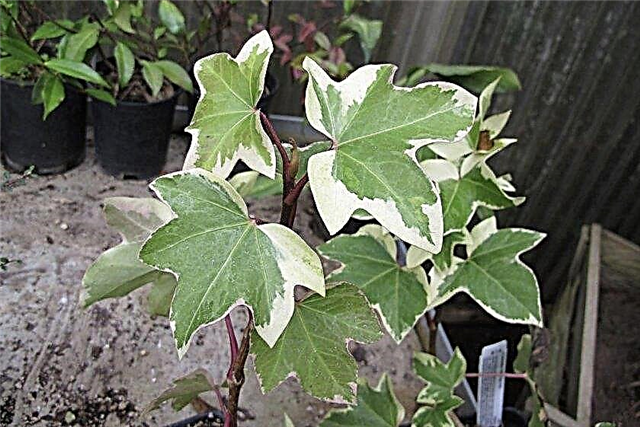
- Pia - the whole is covered with short leaves of a rich green color. They have mottled-wavy edges that tightly adjoin the stem.
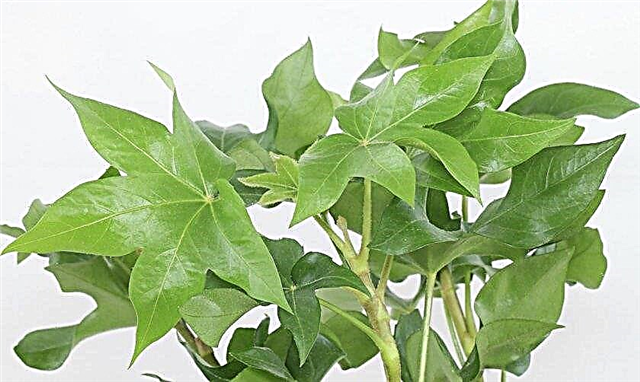
- Silver prince. The name itself indicates the presence of silver - it is with a silver border that each leaf is framed.
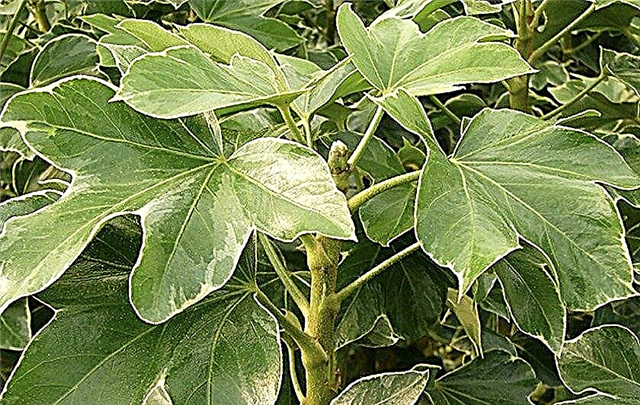
- Golden variety, a special sign of which is a spot of golden (yellow) shade in the center of each leaf.
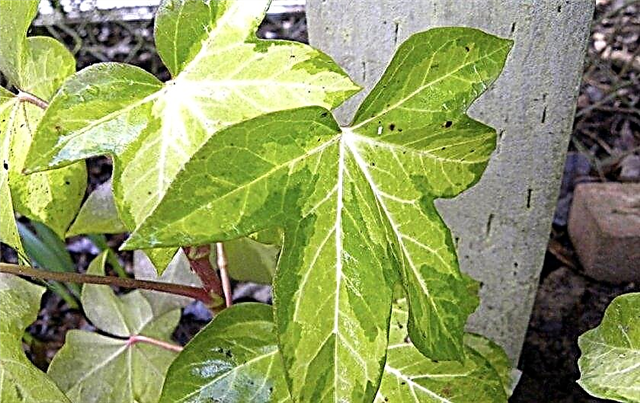
What conditions do you need to create at home
To successfully grow an evergreen vine in your own home, you must provide it with the right place to live, that is, create the necessary conditions.
Seat selection
Fatshedera prefers good light, although it can grow in shaded conditions. The ideal level of light in the room is light partial shade. With the onset of warm seasons, the culture will feel better in the fresh air than in an apartment, for this purpose it is recommended to be transplanted into the street. A shady courtyard is best.
Important! The main rule: the flower must be protected from direct sunlight — the rays of the sun can cause burns to its leaves.
Temperature and humidity
Liana is resistant to high spring-summer-autumn temperatures, but when the temperature rises above + 25 ° C it can become dull and lethargic. The optimum temperature in winter is +10 ... + 15 ° С.
Humidity should be moderately high. If the air temperature rises above + 18 ° C, it is advisable to spray the culture, organize a kind of shower. Such procedures are also useful for hygienic reasons, since they clean the leaves of the flower from dust and have a disinfecting effect. Conduct moisturizing procedures should be every 7 days. In addition, it is worth cleaning the leaves from dust with wet wipes once a week. "Frenchwoman" should be protected from drafts and cold air currents.
"Frenchwoman" should be protected from drafts and cold air currents.
How to care at home
Fatsheder flower care consists in organizing watering, feeding, pruning, transplanting. Details for each item.
Watering
In warm and hot times (spring-autumn), the culture needs to be provided with frequent and plentiful watering, but you should not over-moisten the soil, as this can provoke root diseases of the plant. The liquid that has accumulated in the pan should be poured. In winter, the number of watering is reduced. Approximate recommendations regarding the frequency of irrigation, depending on air temperature:
Approximate recommendations regarding the frequency of irrigation, depending on air temperature:
- at a thermometer + 24 ... + 26 ° С the flower is watered every 2-3 days;
- at a temperature of +20 ... + 24 ° C, the interval between irrigation is 5-6 days;
- at a temperature of +16 ... + 18 ° C you need to water once a week and a half;
- at +12 ... + 15 ° С one moistening per month is enough.
Important! Fatshedera will report waterlogging with yellowed leaves, and a lack of moisture — a change in the shape of the crown and foliage falling down.
The best water for irrigation is rain or sediment, room temperature. Type of irrigation - drip irrigation, can be combined with spraying.
It is advisable to provide the root system of the flower with good drainage. So, the drained substrate should be 30% of the total mass of the earth (the remaining 2/3 of the soil should be a sand-sod mixture with humus in the proportions 1/2/1). As a drainage material, it is best to use small particles of expanded clay or broken bricks.
Top dressing
At a time when Fatshedera is growing most actively (early April - mid September), it needs to be supplied with high-quality and regular fertilizers. Top dressing should be complex, organic and mineral in nature, they should be alternated. Frequency of top dressing - 1 time for 10-14 days. With the onset of winter, fertilizer processes cease as the Fatshedera enters a state of rest. The necessary fertilizers can be purchased at specialized flower shops: you should ask for fertilizing for decorative and deciduous crops, for example, Vympel-2, Master Elite, Alliance, Agricola, Bona Forte and others.
The necessary fertilizers can be purchased at specialized flower shops: you should ask for fertilizing for decorative and deciduous crops, for example, Vympel-2, Master Elite, Alliance, Agricola, Bona Forte and others.
Pruning
Fatshedera is a plant that is distinguished by its elasticity, flexibility and plasticity. Despite such data, without trimming, it can form one strong central shoot (stem), which negatively appears on the development of the lateral ones. This can lead to a decrease in decorative functions, that is, without trimming, its appearance will suffer. Fatsheder is trimmed after it reaches a height of 30 cm to stimulate the branching process.
Important! Often the lateral shoots develop poorly even after pruning - they can dry out, and even with all the necessary care rules, the bush will branch poorly, have a poor and depressed look. To grow a lush and shrubby vine, plant 2-3 seedlings in one pot and cut each of them in a timely manner.
Transfer
French creeper is recommended to be transplanted annually until the age of 5 years is reached; after this, the plant should be transplanted every 2-3 years (at the same time, the topsoil should be changed annually). But, if you want to become the owner of a magnificent and graceful fatshedera, then do not be lazy and transplant it every year, regardless of age. The capacity for planting should be deep and not wide, which will allow you to drain the bottom of the pot well without compromising the growth of the root system. It is worth remembering the increase in the size of the container under the flower. So, each next pot should be 2-3 cm in diameter larger than the previous one. The best time for transplanting is early spring (approximately - early April), before the growing season. Soil acidity should be low or neutral. The transplantation of a liana should be carried out by the method of transshipment, that is, maintaining an earthen lump.
The capacity for planting should be deep and not wide, which will allow you to drain the bottom of the pot well without compromising the growth of the root system. It is worth remembering the increase in the size of the container under the flower. So, each next pot should be 2-3 cm in diameter larger than the previous one. The best time for transplanting is early spring (approximately - early April), before the growing season. Soil acidity should be low or neutral. The transplantation of a liana should be carried out by the method of transshipment, that is, maintaining an earthen lump.
This process should consist of the following steps:
- Pot and soil preparation.
- Slight moistening of the soil under the plant for 2-3 days before the transplant process. This is necessary so that a lump of earth does not crumble.
- Extraction of the fatsheder from the previous tank, together with the ground. To safely remove the plant, you need to put the pot on a flat and hard surface and knock a bit on its edges. You can also gently draw along the inner edges of the pot with a knife and separate the earth from the walls of the tank. Then the vine is carefully pulled out. To safely remove the pot, you can turn it on its side.
- Inspection of the roots to remove diseased or rotten. If during the examination, diseased or damaged by pests roots were found, then the root system is completely cleaned of the soil in which it grew, and the foci of diseases on the roots are removed. If none were found, it is only necessary to remove the top layer of the previous soil, as well as clean the lump from the remnants of the previous drainage (roots that have grown into the old drainage system must be removed).
- Putting a creeper in a new container. The root system is transferred to a new pot, filling the free space between the lump of earth and the edges of the tank with a new substrate. It is worth remembering that the distance from the top of the pot to the topsoil should be 3 to 5 cm.
- Compliance with the features of irrigation. Given the fact that the culture was moistened for 2-3 days before transplantation, it is not necessary to water it immediately after transplantation. The plant needs to be given some time (1-3 days) to dry the wounds formed on the roots during the transplant procedure.

How to propagate
"Frenchwoman" propagated by cuttings, seed method, as well as aerial layering.
Cuttings
It is carried out in warm time, best of all the end of spring - the beginning of summer. To do this, cut apical shoots 15 cm long, place them in a container with a substrate prepared from turf, humus and sand (2/1/1), and create greenhouse conditions, that is, cover with a film. With the appearance of the kidneys on the handle, the film can be removed.
Air layering
The most simple and popular method of propagation of culture. Begin such a procedure in early April. The leafless stem of one of the shoots is slightly incised, moist sphagnum is applied to the incision site and wrapped with a film. Provided that the moss will always be wet, after 2 months new roots will appear on the cut-off place of the stem. Then the root-covered part of the stem is cut out and placed in a pre-prepared pot with a substrate.
So that the new plant is well rooted, the soil under it must be regularly moistened. It is also worth taking care of high humidity: cover the young plant with a film or even a glass jar (for 7 days), which also contributes to its rapid rooting.
Seeds
This method is carried out using exclusively freshly harvested seed material (seeds ripen on an adult plant and can be collected independently at home). Fresh fruits are placed in a substrate without deepening, sprinkled with soil a little and create greenhouse conditions using a film, glass or bag. Then the container is placed in a warm (+ 27 ° C) and dark room and waiting for seedlings, which will appear a month later.
Growing difficulties
A Fatsheder grower may experience the following problems:
- Yellowing of the tips of the leaves, their fragility, spotting, dryness. This phenomenon is provoked by insufficient watering of the crop, or it grows in too hot conditions (air temperature exceeds + 25 ° C). Solution: increased watering and humidification.
- If the leaves of the flower began to frown and became covered with large spots of brown color, the plant received a sunburn. Do not forget to hide it from direct sunlight.
- The pallor of the leaves and their loss of glossy gloss indicates a lack of light. Liana should be moved to a more lighted place.
- The culture withers before our eyes, becomes dull, becomes covered with a downy plaque of gray color - That means she is cold and the air is too humid. Solution: move the flowerpot to a room with the appropriate temperature and humidity. After relocation, remove the drooping leaves, loosen the soil under the vine and spray it with fungicide.

Important! Slight leaf fading in an adult Fatsheder — this is not a growing problem, but a natural process.
Home value
Along with genetic characteristics, Fatshedera adopted some signs and superstitions from ivy. So, it is believed that the flower has a bad effect on men, producing negative energy and aggression. The most superstitious say that a liana can even survive a man from home: at best, he just leaves, at worst he dies. In the house where Fatshedera grows, representatives of the stronger sex will always try to leave the room with a flower, or not even go into it.
In addition, fatscheder, like ivy, is classified as a plant - energy vampires that absorb optimism, cheerfulness, self-confidence, peace of mind. But if you plant a creeper outside the house, then it will turn from an offender into a defender: it will become a kind of armor through which negative emotions and aggressive energy cannot get into the house.
But if you plant a creeper outside the house, then it will turn from an offender into a defender: it will become a kind of armor through which negative emotions and aggressive energy cannot get into the house.
However, there is an alternative opinion that Fatshedera is also useful inside the house - it cleans the biofield of the home, stimulates optimism and good thoughts among residents, develops calm and confidence.
Did you know? Fatshedera is especially suitable for those born under the signs of Libra and Virgo.
As you can see, becoming the owner of an exotic plant with the unusual name “Fatshedera” is quite simple. The belief that the “Frenchwoman” is capricious does not come true in the case of this flower, since it does not require special care or conditions. But if you are a superstitious person, you should think carefully before acquiring a fatsheder so as not to harm yourself or the flower.





